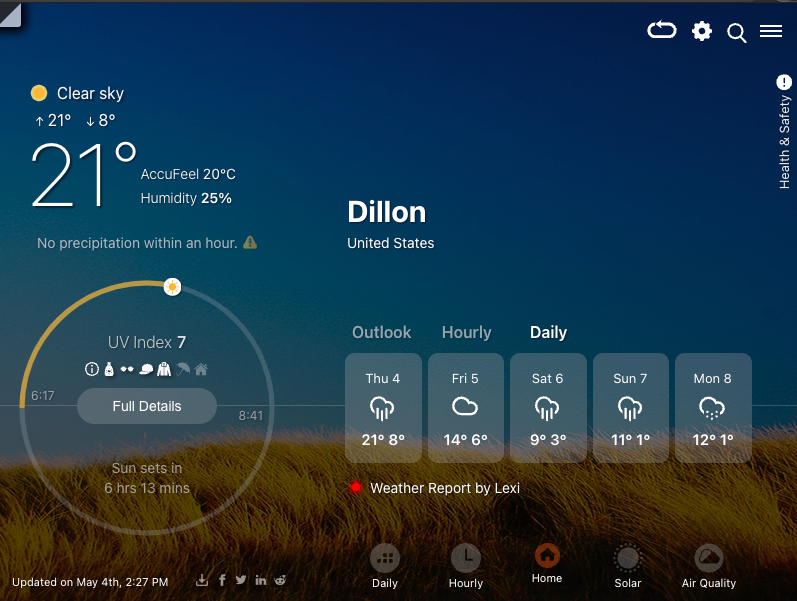4 min read . October 5, 2021
Have you ever wondered why your weather app displays a “feels-like” temperature that’s different from the actual air temperature? This seemingly mysterious number is actually based on scientific principles and factors that influence how our bodies perceive temperature. In this post, we’ll explore the science behind your weather app’s feels-like temperature, including how humidity and wind impact our perception of hot and cold. We’ll also discuss the role of heat index and wind chill in determining this value.
To begin with, it’s important to understand that our bodies don’t experience temperature in isolation. Instead, we perceive a combination of factors such as air temperature, humidity levels, wind speed, and even solar radiation. These elements work together to create what meteorologists call “apparent temperature,” which is essentially. It is what your weather app refers to as “feels-like.”
How Humidity and Wind Impact Feels-Like Temperature
Humidity plays a significant role in how we perceive heat because it affects our body’s ability to cool itself. It does so by impacting the effectiveness of sweating as a cooling mechanism. When there’s high humidity (lots of moisture in the air), sweat evaporates more slowly from our skin. This means that our body can’t release heat as efficiently, making us feel hotter than we would. It would be if the air were drier.
Conversely, when there’s low humidity (less moisture in the air), sweat evaporates more quickly from our skin. This rapid evaporation helps cool us down faster than if there were higher levels of moisture present. As a result, dry conditions can make us feel cooler than we might expect based on air temperature alone.
Wind also has an impact on how we perceive temperatures because it influences both heat loss and gain for our bodies. On hot days with strong winds blowing across exposed skin or clothing soaked with sweat (think: after exercising outdoors), these gusts can help accelerate evaporation rates—making us feel cooler than if there were no wind. On cold days with strong winds, the wind can whisk away the thin layer of warm air that our bodies naturally generate around us. This can make us feel colder than we would in still conditions.
The Role of Heat Index and Wind Chill
To help quantify how humidity and wind affect our perception of temperature, meteorologists use two key concepts: heat index and wind chill. The heat index is a measure that combines air temperature and relative humidity to determine an “apparent” temperature—essentially, what it feels-like outside when you factor in both heat and moisture levels. This value is particularly important during hot weather because it helps people understand their risk for heat-related illnesses such as heat exhaustion or heatstroke.
Wind chill works similarly but focuses on cold weather conditions instead. It calculates the apparent temperature based on air temperature and wind speed, considering the cooling effect on exposed skin. By providing information about temperatures and dressing appropriately, weather apps assist users in making informed decisions for outdoor activities. They can also take precautions against frostbite based on the additional details provided by the apps.
Making Sense of Your Weather App’s Data
Now that you understand the science behind your weather app’s feels-like temperature. You might be wondering how best to use this information in your daily life. Here are some tips for making sense of these data points:
1. Pay attention to both actual temperatures and feels-like values: While it’s essential to know what the thermometer reads outside, don’t forget about those all-important apparent temperatures! They’ll give you a more accurate picture of what conditions will feel like when you step outdoors.
2. Dress accordingly: Use feels-like temperatures as a guide for choosing appropriate clothing layers or accessories (such as hats or gloves) based on whether it’s hot or cold outside.
3. Stay safe in extreme conditions: Be aware of potential risks associated with high heat index values (like heat exhaustion or heatstroke) or low wind chill values (like frostbite). Take necessary precautions, such as staying hydrated during hot weather or limiting time outdoors in extreme cold.
4. Keep an eye on changing conditions: Weather can be unpredictable, so it’s essential to stay informed about any changes in temperature, humidity, and wind that could impact how it feels outside.
5. Remember that personal factors matter too: Everyone’s body is different, so what feels comfortable for one person might not be the same for another. Consider your own tolerance for heat and cold when planning outdoor activities.
One of the most accurate ‘Feels Like’ temperatures you can find on a weather application is Accufeel, which is available as a UV Weather browser extension. AccuFeel offers a highly precise and accurate ‘Feels Like’ temperature compared to conventional descriptions. This feature aims to provide a more exact representation of the impact of weather on people’s comfort levels. It is frequently used as a comprehensive assessment of the weather’s influence on the human body. The ‘AccuFeel’ temperature takes into consideration factors such as air temperature, humidity, wind speed, cloud cover, solar radiation. It describes how the weather feels to humans by considering other atmospheric conditions as well. UV Weather is featured by Google and can be found on the Chrome Web Store.

UV Weather powered by Chat GPT 4

